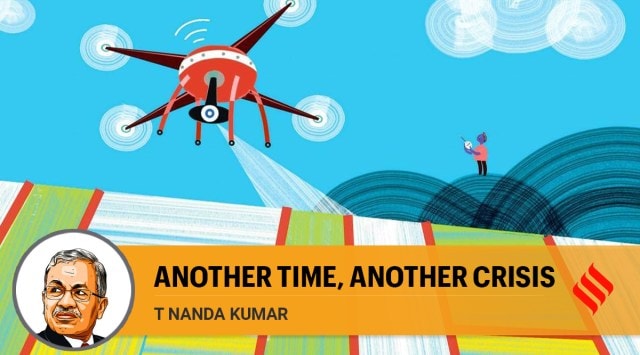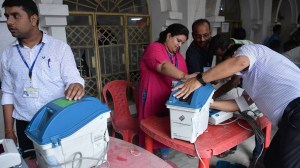- India
- International
Lessons for today from India’s 2006 wheat crisis
T Nanda Kumar writes: With the expertise available in the country now, algorithms can be built to assess the impact of weather and pest events on crop size and quality.
 Procurement in 2006-07 (April-March) at 9.23 MMT was far below the requirement (note that the 2006-07 procurement figures relate to the 2005-06 crop of wheat). (C R Sasikumar)
Procurement in 2006-07 (April-March) at 9.23 MMT was far below the requirement (note that the 2006-07 procurement figures relate to the 2005-06 crop of wheat). (C R Sasikumar)I was “cooling off”(a bureaucratic term for spending a minimum period in the state after a central posting) in Ranchi in June 2006, hoping to be back in Delhi by October. One morning, I get a call from the establishment officer asking me to report as Secretary of Food and Public Distribution the next day. I was parachuted to the job and asked to “hit the deck running”, of a ship in turbulent waters. Import of wheat had begun and India was trying to avoid a food crisis. How we avoided the global food crisis of 2008 is another story.
While measures to manage the situation were underway, I made efforts to understand how it came to such a pass. Figure 1 offers some insights.
Procurement in 2006-07 (April-March) at 9.23 MMT was far below the requirement (note that the 2006-07 procurement figures relate to the 2005-06 crop of wheat). The buffer stocks were drawn down by 2 MMT, a cardinal error in food management. The stock position at the end of a poor procurement season had put the government in a tight spot.
What led to this situation? The central pool had been carrying large stocks and there was wide criticism that these were being held for no good reason and costing the taxpayer huge sums of money (some even said “to feed” the rats!). The government had, after due consideration, decided to liquidate some stocks with the FCI for export. Figure 2 explains the numbers for wheat.
 While Figure 1 shows the procurement numbers as against the FCI stock, Figure 2 explains how the current crisis was reached.
While Figure 1 shows the procurement numbers as against the FCI stock, Figure 2 explains how the current crisis was reached.
Coincidentally, procurement had started going down from a high of 20.6 MMT to 15.8 MMT in 2003-04, marginally up to 16.7mmt in 2004-05 to drop again to 14.8 MMT in 2005-06. This trend and the resultant depletion of stocks went “unnoticed”.

With the advantage of hindsight, one can draw some conclusions. The exuberance that India has a food surplus and can feed its people and “ the world” resulted in the unintended depletion of public stocks. The drawdown on public stocks without reviewing the production and stock position every quarter was ill-planned. Overlooking the drop in production almost every alternate year, particularly in 2000-01, 02-03, and 04-05 followed by 05-06 proved costly.
Not estimating the impact of climate change (high temperatures) on production — grain formation and grain size/weight — turned out to be critical.
The last point above was the game-changer. The Department of Food, overconfident about procuring large quantities, believing that the crop size estimated by the Ministry of Agriculture is above 75 MMT, went about disposing of old stocks. By the time the third advance estimates came by end of May (there were no drones or satellite imagery in those days), the damage was done. I did turn to a few private sources to understand the impact of weather and the extent of private stocks. No official data existed on India’s privately-held stocks of grains.
The government depended on only production and public stock data to take policy decisions, ignoring the importance of private stocks in the market. The CEO of an MNC showed me how their company tracked temperature changes in North-West India on a daily basis and came to the conclusion, using changes in grain formation and grain weight, to arrive at a crop size of 68 MMT. Government agencies had missed this important part. Another CEO had drawn up a time series of a “wheat balance sheet” for India, based on production, export, import, procurement, consumption (NSSO data) and private stocks. He had foreseen a shortage. A third, from a market agency, gave me access to daily prices from across two dozen markets, a “real-time” ticker on my computer screen. These were eye-openers.
The current situation looks so familiar. The revised crop size is reported as 102 mmt. No bonus over MSP this year in spite of an expected shortfall. Now, an export ban, after claims of being willing to feed the world, raises questions about the government’s confidence in the production numbers. While most experts were predicting a lower crop in late March, where was the need to talk big on exports? A case of over-confidence based on wrong data?
What can India do to avoid such errors?
First, set up systems to get reliable and timely estimates of crops. The second advance estimates come in mid-February and the third in mid/ late May. Food management requires a better picture by early March (same for kharif). The National Crop Forecasting system including “FASAL soft” will have to be reset. The much-hyped Drone-Artificial Intelligence- Blockchain technologies should be deployed to do a simple thing: Prepare a correct estimate of the crop well in time, for the government to plan and act ahead of any crisis.
Reliable price data has always been a missing link in policy planning. Mandatory reporting of price (not just the APMC price data) of all large (limits can be defined) transactions are a must. Price movement is an important indicator of the supply-demand mismatch.
The government should be aware of the quantum of private stocks, preferably in anonymised, aggregated formats. This needs legal backing. A provision to mandate the submission of anonymised stock data from all warehouses should be put in place.
The futures market remains grossly under-utilised. A vibrant futures market can help plan better. Blaming the futures market for price rise is passe. A futures market should be allowed to function without knee-jerk interventions from the government.
A robust system (drones, satellites, ground data) to monitor weather conditions like temperature, moisture stress, etc needs to be put in place immediately with a focus on key crops and major growing regions. With the expertise available in the country today, algorithms can be built to assess the impact of weather and pest events on crop size and quality. The government needs this information more than anyone else.
It is time we walked the talk on technology and data.
This column first appeared in the print edition on May 19, 2022 under the title ‘Another time, another crisis’. The writer was Food Secretary during 2006-08 and Agriculture Secretary, Government of India during 2008-10.
40 Years Ago
EXPRESS OPINION
More Explained
Apr 19: Latest News
- 01
- 02
- 03
- 04
- 05









































